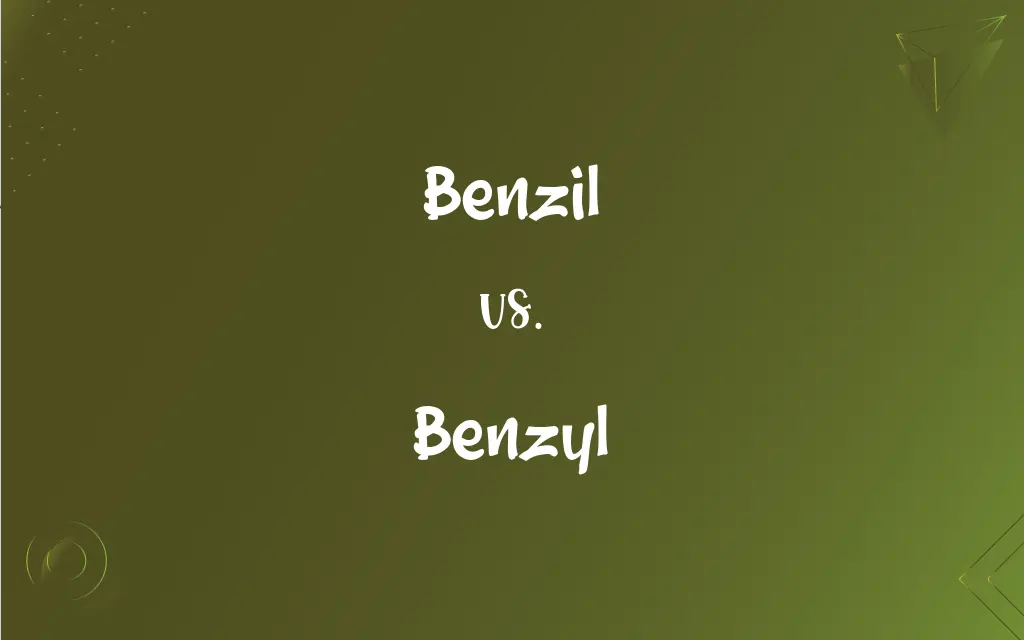Benzil vs. Benzyl: What's the Difference?
By Harlon Moss & Aimie Carlson || Updated on May 22, 2024
Benzil is a diketone compound used in organic synthesis, while benzyl is a functional group or radical derived from toluene, often used in chemical and pharmaceutical contexts.

Key Differences
Benzil (C14H10O2) is an organic compound characterized by two benzene rings connected through a diketone (two carbonyl groups). It is primarily used as an intermediate in organic synthesis and in the production of various chemicals and pharmaceuticals. Benzyl (C6H5CH2) refers to a functional group or radical consisting of a benzene ring attached to a CH2 group. This group is often encountered in organic chemistry, where it serves as a protective group for alcohols and carboxylic acids.
Benzil, as a diketone, has specific applications in creating complex organic molecules and photochemical reactions. Its structure allows it to participate in a variety of chemical transformations, making it a valuable compound in synthetic chemistry. Benzyl, on the other hand, functions mainly as a reactive intermediate or protective group. It is versatile in forming esters, ethers, and other derivatives, facilitating various chemical reactions by temporarily modifying reactive sites on molecules.
Benzil’s structure features two carbonyl groups, leading to distinct chemical behavior compared to the single methylene (CH2) group in benzyl. This difference in structure dictates their specific uses and properties in chemical processes.
Comparison Chart
Chemical Formula
C14H10O2
C6H5CH2
Structure
Two benzene rings with a diketone
Benzene ring with a CH2 group
ADVERTISEMENT
Primary Use
Organic synthesis intermediate
Functional group in organic chemistry
Applications
Photoinitiators, chemical synthesis
Protective group, pharmaceuticals, polymers
Functional Groups
Contains two carbonyl (C=O) groups
Contains a methylene (CH2) group
Example Compound
Benzil used in photochemical reactions
Benzyl alcohol used as a solvent
Benzil and Benzyl Definitions
Benzil
Employed in organic synthesis as an intermediate.
Benzil is an important reagent in many synthetic pathways.
ADVERTISEMENT
Benzyl
Derived from toluene and used in various chemical reactions.
Benzyl chloride is a key starting material for numerous organic compounds.
Benzil
An organic compound with two benzene rings connected by two carbonyl groups.
Benzil is used in the synthesis of various organic compounds.
Benzyl
A functional group consisting of a benzene ring attached to a CH2 group.
The benzyl group is commonly used as a protective group in organic synthesis.
Benzil
Utilized in the production of pharmaceuticals.
Benzil derivatives are explored for potential medicinal properties.
Benzyl
Used to temporarily modify reactive sites on molecules.
Benzyl protecting groups are removed after the main synthetic steps are completed.
Benzil
A diketone known for its role in photochemical processes.
The chemist used benzil as a photoinitiator in the polymerization reaction.
Benzyl
Involved in the formation of esters and ethers.
The benzyl ester was formed to protect the carboxylic acid during the reaction.
Benzil
Known for its yellow crystalline appearance.
Pure benzil can be identified by its distinct yellow crystals.
Benzyl
Common in the synthesis of pharmaceuticals and perfumes.
Benzyl alcohol is widely used as a solvent and preservative.
Benzil
(organic chemistry) The organic compound 1,2-diphenyl-1,2-ethanedione, a diketone used as an intermediate in organic synthesis and as a photoinitiator for free-radical curing of polymer networks.
Benzyl
The univalent organic group C6H5CH2-, derived from toluene.
Benzyl
The univalent radical C6H5-CH2- related to toluene and benzoic acid
Benzyl
A compound radical, C6H5.CH2, related to toluene and benzoic acid; - commonly used adjectively.
Benzyl
The univalent radical derived from toluene
FAQs
What is benzil?
Benzil is an organic compound with two benzene rings connected by a diketone.
What is benzyl?
Benzyl is a functional group consisting of a benzene ring attached to a CH2 group.
What is the chemical formula of benzil?
The chemical formula of benzil is C14H10O2.
Is benzil used in synthesis?
Yes, benzil is used as an intermediate in organic synthesis.
Is benzyl used as a protective group?
Yes, benzyl is commonly used as a protective group in organic chemistry.
Does benzil have carbonyl groups?
Yes, benzil contains two carbonyl groups.
Can benzil be used in photochemical reactions?
Yes, benzil is used as a photoinitiator in photochemical reactions.
Can benzyl be used in the synthesis of pharmaceuticals?
Yes, benzyl derivatives are common in pharmaceutical synthesis.
Is benzyl derived from toluene?
Yes, benzyl is derived from toluene.
Does benzyl have a methylene group?
Yes, benzyl contains a methylene (CH2) group.
Does benzil have a crystalline appearance?
Yes, benzil typically appears as yellow crystals.
What is the chemical formula of benzyl?
The chemical formula of the benzyl group is C6H5CH2.
Is benzil a diketone?
Yes, benzil is a diketone.
What is an example of a benzil application?
Benzil is used in the preparation of photoinitiators for polymerization.
What industries use benzil?
Benzil is used in the chemical and pharmaceutical industries.
Is benzyl a temporary protective group?
Yes, benzyl groups are used as temporary protective groups in synthesis.
What is an example of a benzyl application?
Benzyl alcohol is used as a solvent and preservative.
What industries use benzyl?
Benzyl is used in pharmaceuticals, perfumes, and polymers.
Is benzyl used in forming esters?
Yes, benzyl groups are used to form esters in organic synthesis.
Is benzil important in synthetic pathways?
Yes, benzil is an important intermediate in various synthetic pathways.
About Author
Written by
Harlon MossHarlon is a seasoned quality moderator and accomplished content writer for Difference Wiki. An alumnus of the prestigious University of California, he earned his degree in Computer Science. Leveraging his academic background, Harlon brings a meticulous and informed perspective to his work, ensuring content accuracy and excellence.
Co-written by
Aimie CarlsonAimie Carlson, holding a master's degree in English literature, is a fervent English language enthusiast. She lends her writing talents to Difference Wiki, a prominent website that specializes in comparisons, offering readers insightful analyses that both captivate and inform.































































